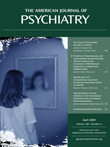Identification of a Schizophrenia-Associated Functional Noncoding Variant in NOS1AP
Abstract
Objective: The authors previously demonstrated significant association between markers within NOS1AP and schizophrenia in a set of Canadian families of European descent, as well as significantly increased expression in schizophrenia of NOS1AP in unrelated postmortem samples from the dorsolateral prefrontal cortex. In this study the authors sought to apply novel statistical methods and conduct additional biological experiments to isolate at least one risk allele within NOS1AP . Method: Using the posterior probability of linkage disequilibrium (PPLD) to measure the probability that a single nucleotide polymorphism (SNP) is in linkage disequilibrium with schizophrenia, the authors evaluated 60 SNPs from NOS1AP in 24 Canadian families demonstrating linkage and association to this region. SNPs exhibiting strong evidence of linkage disequilibrium were tested for regulatory function by luciferase reporter assay. Two human neural cell lines (SK-N-MC and PFSK-1) were transfected with a vector containing each allelic variant of the SNP, the NOS1AP promoter, and a luciferase gene. Alleles altering expression were further assessed for binding of nuclear proteins by electrophoretic mobility shift assay. Results: Three SNPs produced PPLDs >40%. One of them, rs12742393, demonstrated significant allelic expression differences in both cell lines tested. The allelic variation at this SNP altered the affinity of nuclear protein binding to this region of DNA. Conclusions: The A allele of rs12742393 appears to be a risk allele associated with schizophrenia that acts by enhancing transcription factor binding and increasing gene expression.



